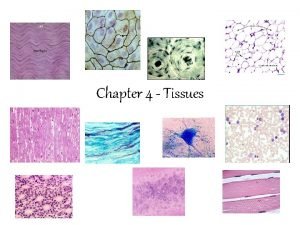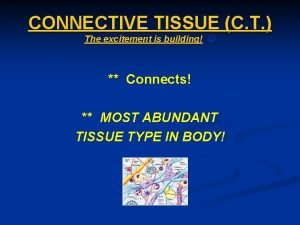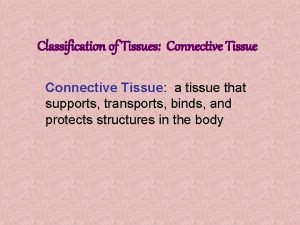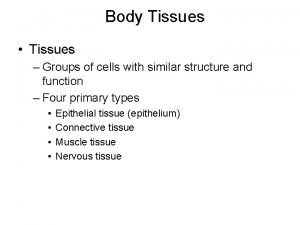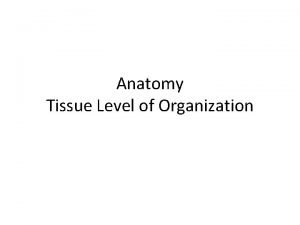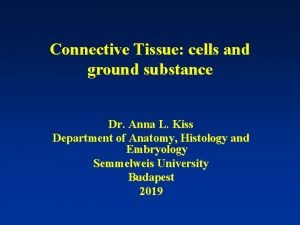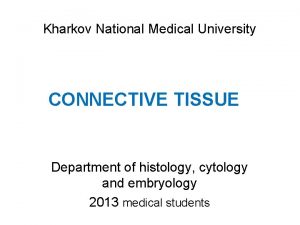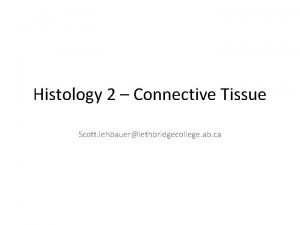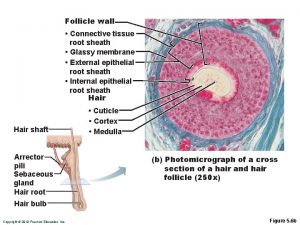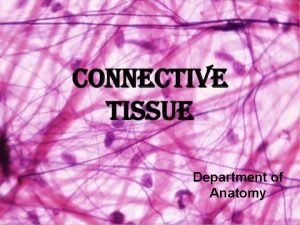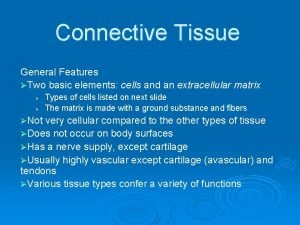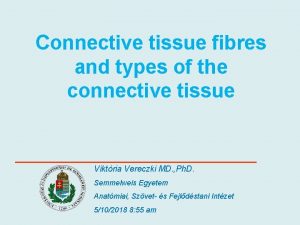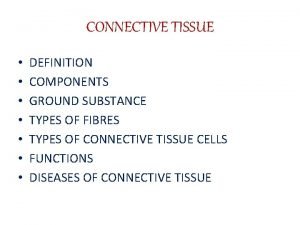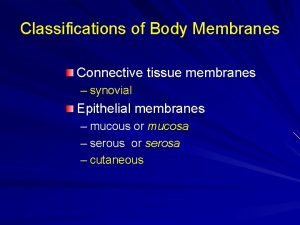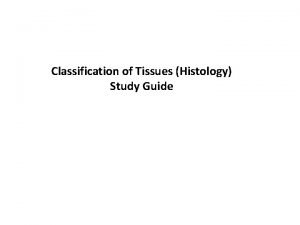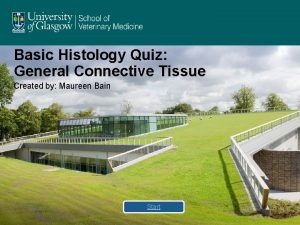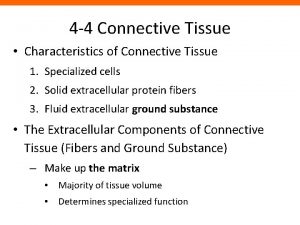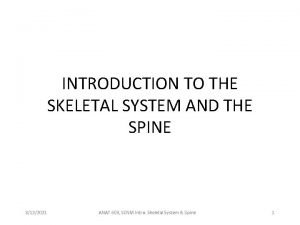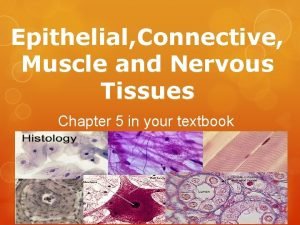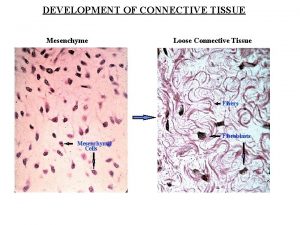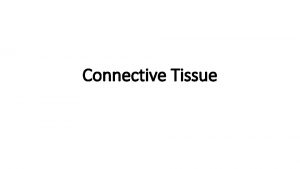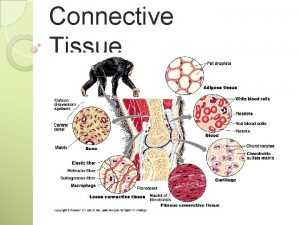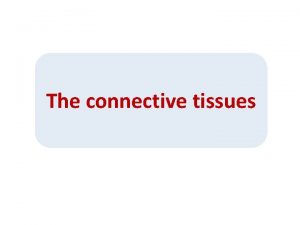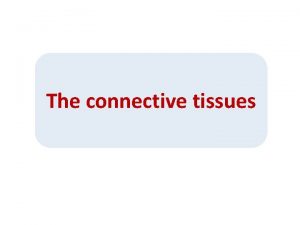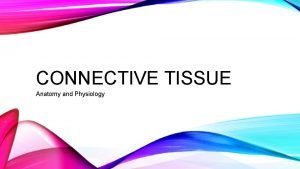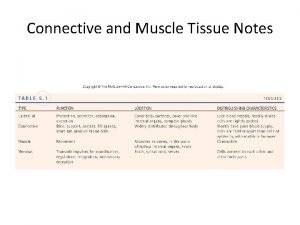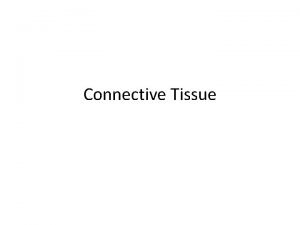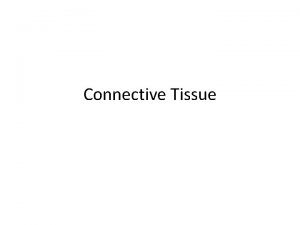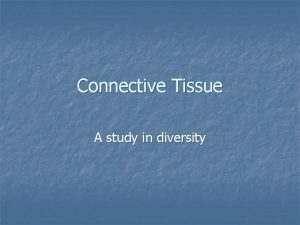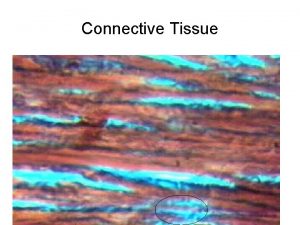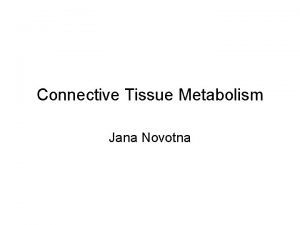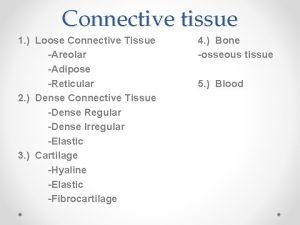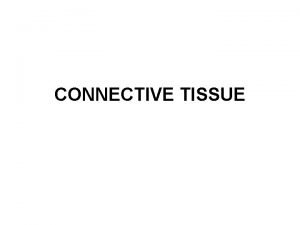Connective and Supporting Tissue I Connective Tissue Includes




























- Slides: 28

Connective and Supporting Tissue I. Connective Tissue - Includes: Bone, Blood, Fat, Tendons, Ligaments, Cartilage

A. Components 1) Specialized Cells 2) Extracellular Protein Fibers 3) Fluid (Ground Substance) Matrix; Surrounds cells Fibers + Ground Substance = B. Characteristics 1) Most of tissue is Matrix; Cells are Sparse 2) Found throughout body; Never exposed to external environment 3) May be highly vascular 4) Many contain sense receptors

C. Connective Tissue Fibers 1. Collagenous Fibers 1. Collagen: most abundant protein among animals 2. Nonelastic, Rope-like bundle of microfibrils 3. Long, Straight, Unbranched 4. Very Strong 2. Reticular Fibers 1. Made of Collagen 2. Very Thin, Branched 3. “Woven Fabric” joining connective tissues to others

C. Connective Tissue Fibers 3. Elastic Fibers 1. Made of Elastin (protein) - elastic properties 2. Long, Branched Threads

D. General Functions 1. Structure (Bone) 2. Transport (Blood) 3. Bind and Support Other Tissues 4. Energy Storage (Fat) 5. Fight Disease (WBCs)

E. Two Major Types 1) Solid 2) Fluid 1) Solid Connecting Tissue (3 Types – Fibrous, Bone, Cartilage) a. Fibrous Tissue: - contains many fibers 1. Areolar Connective Tissue a) Appearance: Open, Loose Fibers b) Function: “Packing Material” -cushions, supports/binds epithelial c) Location: Below Skin, Around Organs and Vessels

Areolar Connective Tissue

2. Tendons and Ligaments a) Appearance: Dense, Parallel Fibers -Nuclei appear flattened b) Function: Tendons: Attach muscle to bone Ligaments: Connect bone to bone c) Location: Tendons: Between muscle and bone Ligaments: At joints, between bone

ACL

3. Reticular Connective Tissue a) Appearance: Woven, Network Appearance b) Function: Provides 3 -D fibrous network; supports cells of organs c) Location: Spleen, Liver, Bone Marrow

4. Adipose Connective Tissue a) Appearance: Large Cells, Yellowish Fat Drops b) Function: Padding, Energy Storage, Insulation c) Location: Under Skin, Gluteal Region, Pericardial and Abdominal Cavities

Adipose Tissue

b. Cartilage: - 3 Types -Cells = Chondrocytes -Lacunae: Pockets in matrix where cells are found

1. Hyaline Cartilage =“Glass” - most common type a) Appearance: Translucent Matrix, No Visible Fibers b) Function: Stiff, Flexible Support, Reduces Friction c) Location: Between Bones, Ribs, Nose, Trachea

Hyaline Cartilage

2. Elastic Cartilage a) Appearance: Close Elastic Fibers, Many Chondrocytes b) Function: Support, Allows for Distortion c) Location: Ear, Epiglottis

From Ear Elastic Cartilage

3. Fibrous Cartilage (Fibrocartilage) a) Appearance: Extremely Dense Fibers, Sparse Chondrocytes b) Function: Resists Compression, Absorbs Shock c) Location: Between Vertebrae, Between Pubic Bones

Fibrous Cartilage

c. Bone a) Appearance: -Cells = Osteocytes -Lacunae: Pockets where cells are found -Collagen Fibers -Ground Substance = 1) Calcium Phosphate 2) Calcium Carbonate

-Basic Unit = Haversian System -Concentric Layers of Matrix (lamellae) and Osteocytes around Central Cavity (BVs and Nerves) a) Function: Support, Storage, RBC, WBC, Protection b) Location: Skeleton

Bone Tissue

F. Fluid Connective Tissue I. Characteristics A. Specialized Cells B. Watery Matrix C. Few Cells relative to Matrix

II. Blood 4 Components A. Plasma: Ground Substance 1. Yellowish in color 2. 90% Water 3. Transports: Nutrients, Wastes, Gases, Hormones, Clotting Agents

II. Blood B. Erythrocytes: Red Blood Cells 1. Biconcave Disk Shape 2. No Nuclei (mammals) 3. Transports O 2 (Hemoglobin)

II. Blood C. Leukocytes: White Blood Cells 1. Defense and Immunity

II. Blood D. Thrombocytes: Platelets 1. Small, Disk shaped cell fragments 2. Function in Clotting Location: Blood vessels

The main purpose of connective tissue is to add support and structure to the body.
 Adipose epithelial tissue
Adipose epithelial tissue Supporting connective tissue
Supporting connective tissue Areolar tissue
Areolar tissue Bone connective tissue function and location
Bone connective tissue function and location Cells and fibres of connective tissue
Cells and fibres of connective tissue Where is adipose connective tissue found
Where is adipose connective tissue found Similar pictures
Similar pictures What type of connective tissue are tendons and ligaments
What type of connective tissue are tendons and ligaments Supporting tissue
Supporting tissue Specialised connective tissues
Specialised connective tissues Nervous tissue
Nervous tissue Fibrocytes
Fibrocytes Function hyaline cartilage
Function hyaline cartilage Hair follicle glassy membrane
Hair follicle glassy membrane Dense irregular connective tissue
Dense irregular connective tissue Identify
Identify The dominant fiber type in dense connective tissue is
The dominant fiber type in dense connective tissue is Spinocellular connective tissue
Spinocellular connective tissue Ground substance definition
Ground substance definition Dense irregular connective tissue
Dense irregular connective tissue Areolar vs reticular connective tissue
Areolar vs reticular connective tissue Connective tissue membranes
Connective tissue membranes Simple cuboidal
Simple cuboidal Connective tissue histology quiz
Connective tissue histology quiz Connective tissue function
Connective tissue function Embryonic connective tissue
Embryonic connective tissue Specialized connective tissue blood
Specialized connective tissue blood Simple cuboidal epithelium function
Simple cuboidal epithelium function Dense irregular connective tissue cells
Dense irregular connective tissue cells



